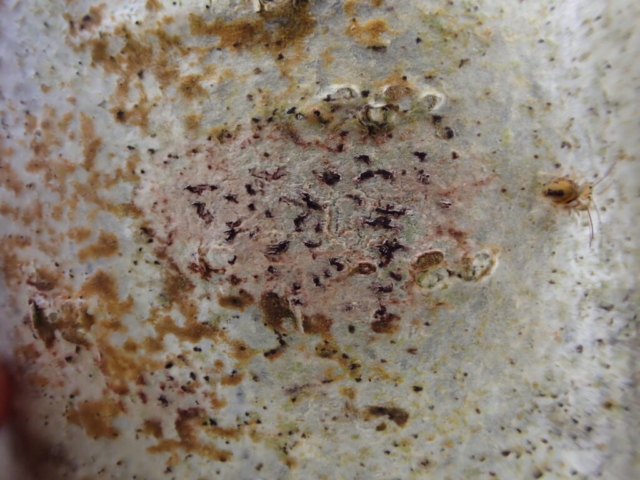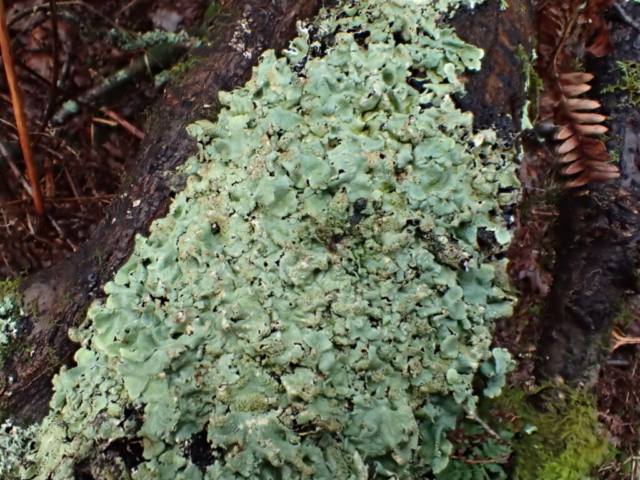This was a popular meeting with 11 people looking at lichens and even more at bryophytes. We car-shared to a point where a few vehicles could park at the edge of the wood and Edward Mills, the owner, gave a brief introduction. He bought the wood in 2020 and is aiming to create a mosaic of different habitats. Management includes coppicing in some areas but there are large old hazel trees too which will be retained. Deer, both roe and red, are a problem currently, limiting natural regeneration.
As you might imagine for a low-lying site (c 30m above sea level at the high points), it’s very damp underfoot with recent rain also having wetted every surface. Some lichens were doing very well in these circumstances – the first thing seen after only a few metres were stunning sheets of Baeomyces rufus covered in a sward of tiny mushroom-like fruiting bodies on exposed rock by the track. Here too we started to examine the trunks and twigs of nearby willow, birch and alder, finding various common lichens – bitter-tasting Lepra amara, Evernia prunastri pretending to be a fruticose lichen, various Hypotrachyna spp and Platismatia glauca amongst others. Further on there were oak trees on drier ground where Micarea alabastrites and Pachyphiale carneola were spotted by Allan, with Normandina pulchella and Peltigera praetextata found by Chris.
This first part of the wood was fairly dark which might account for the limited range of lichens. Further on we began to see hazel trees which overall had a good range of crustose species, especially lirellate ones (with scribble-like fruiting bodies). The best of these were in the southern part of the wood where it was more open and well-lit. Here we found red-pink pruinose Coniocarpon cinnabarinum, Coniocarpon cuspidans with immersed purple lirellae, Arthonia didyma with tiny fleck-like apothecia and Opegrapha niveoatra, as well as Graphis scripta sensu stricto. Some of these were checked under the microscope later. Throughout, on mature oak, there was a lot of Diarthonis spadicea (was Arthonia) with “arthonioid” round apothecia with blurry edges. Another nice find was the glue fungus, Hymenochaete corrugata, which bonds dead branches and twigs together above ground, so avoiding competition from other fungi.
Lunch was on the bank of the tidal Rusland Pool watercourse where there were also a few species on the wooden rails of the bridge and on a gate. These included Fuscidea lightfootii, Micarea lignaria and Candelariella vitellina.
After this we cut back across the denser wood but found several canopy species where an oak had fallen allowing us to look at the topmost twigs. Here there was Usnea subfloridana, a genus which likes lots of light so lives in the canopy until a storm brings it down to our level. Nearby rock outcrops had several nice crustose species, including pink-orange sorediate Gyrographa gyrocarpa growing with purple-brown Enterographa zonata with pale soredia, forming mosaics.
The centre of the wood has some established rhododendron which looked as though it was in the process of being tackled. Holly was frequent in the wood, a tree lichenologists tend to dislike as it casts year-long dense shade on adjacent trunks, badly affecting lichens there. On the other hand old holly trees are lovely and support good lichens. Xanthoria parietina was scarce, seen only once, which is a good thing.
As usual we had a good time with lots of lichen chat and looking at nice things in a wood new to us.
Text: Caz Walker
Photos: Chris Cant, Caz Walker













